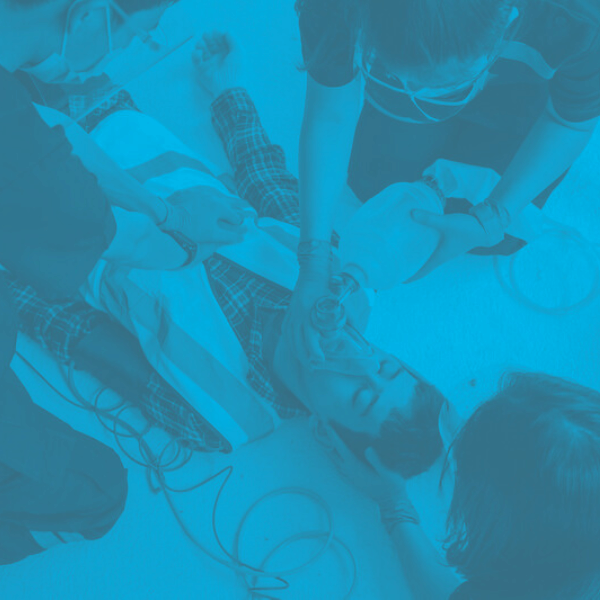Study Shows Adherence to ACLS Protocols Improves Outcomes
Study Shows Adherence to ACLS Protocols Improves Outcomes

by Greta Kviklyte
Life Saver, AMC
Co-authored by Kim Murray, RN, M.S.
posted on Jul 30, 2021, at 4:00 pm
It’s one thing to learn ACLS Protocols and obtain an ACLS certificate. But it’s quite another to use what you’ve learned consistently when a life hangs in the balance.
This has given researchers an opportunity to compare outcomes with ACLS Protocols, which are followed precisely and when they’re not. That’s exactly what this study attempted to find out.
ACLS Protocol Study Findings
In this study published at NIH.gov, researchers reviewed the records of 149 patients who had had an in-hospital cardiac arrest (IHCA).They wanted to see the overall compliance with ACLS Protocol in each case, and how this impacted patient outcomes.
We offer Online ACLS Certification and Renewal
Roughly 1/2 of the patients experienced a successful return to spontaneous circulation (ROSC), while the others did not survive.
As with any good study, the scientists looked at additional confounding factors and circumstances that may have influenced whether or not the patient experienced ROSC to account for it.
CPR, BLS, and even ACLS Protocol don’t always work. That’s certainly not a poor reflection of the resuscitation team.
Their adjusted analysis positively correlated the number of correctly followed steps in ACLS Protocol to ROSC. Conversely, they found that the number of steps missed (whether commission and omission errors) strongly predicted a failure to return to spontaneous circulation from an in-hospital cardiac arrest.
That may be just one small-scale study. But numerous well-conducted studies support the fact that adherence to the ACLS Protocol improves outcomes. And they also show that the rate of compliance with ACLS Protocol is certainly a place where many facilities have room for improvement.
Let’s quickly look at some of these other studies and then discuss ways healthcare leaders and individuals can improve adherence to ALCS and patient outcomes.
Supporting Evidence in Favor of Improving ACLS Protocol Compliance
 Another study compared patient outcomes for medical professionals who had received ACLS training to those who hadn’t. As a control, they used the same group of medical professionals, pre- and post-training.
Another study compared patient outcomes for medical professionals who had received ACLS training to those who hadn’t. As a control, they used the same group of medical professionals, pre- and post-training.
They observed 284 pre-training cardiac events and 343 post-training events. After receiving the training, the number of people who experienced ROSC improved by 1/3 from 18.3% ROSC to 28.3% ROSC.
This same study also found that survival to discharge went up significantly in the post-ACLS training group, 69.1% compared to a meager 23.1%.
Another group of Canadian researchers sought to determine factors within our control that could increase survival following in-hospital cardiac arrests. They also found that how well a team adhered to ACLS protocols was the defining factor.
On average, a resuscitation team deviating 2.3 times from ACLS protocol still achieved ROSC. But those who had 3.9 or more deviations did not. This was after they accounted for confounding factors.
How ACLS Protocol Improves Team Function
How does adherence to ACLS protocols improve patient outcomes as these studies show? In addition to being scientifically researched best practices in-line with ILCOR standards and methods, there’s something else going on here. And we’ll turn to the Journal of Applied Psychology to find out what.
Here, you’ll find a study that has little to do with ACLS but everything to do with how effective teams work together. It shows that when a team has a shared mental model (a.k.a: protocol) they make better decisions individually and work together more effectively.
Divergent thinking is certainly helpful in situations where people need to think outside of the box like marketing or business risk management. But when it comes to emergency situations, great teams think alike.
In the case of ACLS protocol, that’s because they’ve all had the same CPR, BLS, and ACLS training.
There’s something to be said about thinking similarly in a crisis.
Is that a shockable rhythm (bradycardia, tachycardia, or asystole), or is it unshockable (e.g., PEA arrest)? If someone in the team is not familiar with ACLS protocol, this could become a debate when split-seconds matter. But there’s no debate for someone who is following ACLS protocols.
ACLS protocol accentuates having an effective resuscitation team. Outside of a hospital, you may have a lone rescuer who is performing CPR while awaiting emergency responders. But in the hospital, you have Code Blue and a dozen or more emergency responders during a cardiac event. Each member of this team should have a role and know exactly how to perform that role according to ACLS protocol. Otherwise, they just get in the way. Mistakes happen. Time is lost.
ACLS protocols include guidance like this that allow you to build a more effective team.
Every resuscitation team needs an effective leader whose responsibilities include:
- Organizing the group
- Monitoring how individuals and the team perform
- Having the ability to perform any skill in case they need to step in if a team member is not doing the job correctly, but also the judgement to know when this is appropriate and in the best interest of the patient
- Directing the team members and ensuring they are staying within their roles and doing them correctly.
- Providing constructive feedback to the team after the emergency has passed to continually improve the team’s effectiveness
Each team member also has a role to play:
- Understanding what their role is in staying within it
- Learning and maintaining the skills to perform that role to the best of their ability
- Knowing ACLS sequences by heart
- Feeling committed to the success of the resuscitation team
Note: a cardiac event is an opportunity to practice skills that an individual has already acquired and, to some extent, mastered. It is not the time to try out new skills that the team member may perform inadequately.
Tips to Improve ACLS Protocol Adherence
 The evidence is clear. Protocol adherence saves lives. But team leaders and team members don’t always follow the protocol. As a team leader, what can you do about that? We have some tips.
The evidence is clear. Protocol adherence saves lives. But team leaders and team members don’t always follow the protocol. As a team leader, what can you do about that? We have some tips.
1. Good Communication Is Critical
To err is human, but in Code Blue, a simple slip of the tongue can lead to less than desirable results. Poorly communicated instructions can have dire consequences in an environment where life is literally hanging in the balance.
To help avoid communication mishaps, it’s important to maintain communication throughout the procedure to ensure patient safety and proper team coordination.
2. Build a Mutual Respect Relationship
Your team may include a variety of professionals, such as doctors, nurses, EMTs, and paramedics. You may have some advanced interns and medical students in the mix if you’re a teaching hospital.
Each of these individuals has varying levels of education and skill. You’ll have obvious power dynamics in a mixed group like this. But they all deserve respect as part of your team.
This includes showing respect for team members even when they make mistakes or the outcome isn’t what everyone had hoped for. Shaming and berating someone openly or talking behind her back serves no constructive function in a team.
When team members have confidence that others on the team have their backs, they will perform better. And they will be more responsive to constructive criticism rather than getting defensive.
3. Encourage Constructive Intervention
When you have mutual respect for all team members, everyone feels comfortable and confident intervening if they feel a mistake is being made. If a doctor calls out a fatal medication dose during tachycardia and a nurse catches it, that nurse should feel confident speaking up rather than following orders.
This isn’t just respect for a team . It’s respect for human life and the realization that people make mistakes. One of the powerful benefits of working as a team is that each member of the team can keep others accountable.
A team member should feel a duty to intervene if they know something is wrong during the code and feel confident that they will not be reprimanded for correcting another team member.
And of course, with ACLS protocol, that correction is based in fact call mom right or wrong according to the algorithm, not someone’s opinion.
4. Foster Closed Loop Communication
Closed loop communication revolves around repeating back orders to confirm what someone has said. How often have you thought you said something correctly only to have it repeated back to you and you then realize your error?
Human memory and speech have hiccups sometimes. Or background noise may make something hard to hear. Either way, closed loop communication gives everyone on the team a chance to make sure they heard that order correctly.
5. Use Everyday Language
The medical industry is filled with acronyms and jargon that everyone understands. You can fairly confidently use this common medical terminology in a medical setting.
But an emergency situation is not a time to show off one’s vocabulary range.
Terminologies used by the team should align with the shared ACLS protocol. In order for that to happen, everyone on the team must have the same ACLS training.
6. Employ Active Listening
Active listening is a skill that many people do not learn until adulthood. As a team leader, it’s important that you do not take listening for granted, or think everyone inherently knows how.
An active listener not only listens carefully. They don’t make assumptions. So if they think they may have misunderstood something, they ask for clarification.
By doing so, you can all follow ACLS protocol together.
7. Use the Algorithms
In order to adhere to ACLS protocol, the team must understand and consistently apply the algorithms. That’s why they exist.
These algorithms help team members stay incredibly familiar with the dosages and indications for the required medication according to ACLS protocol.
Every team member should be individually responsible for memorizing the ACLS algorithms, keeping a copy of them on hand, and using them during a Code Blue. Digital and pocket references for the ACLS algorithms are available.
As a team leader, when you put appropriate focus on the algorithms, you help your team spot possible errors and failure to follow ACLS Protocol. This keeps the focus off of whether an individual in the room is right or wrong. The only “right” is according to ACLS Protocol.
8. Keep Team ACLS Training Up-to-date
In order for a Code Blue team to work together, they must all have the same training. But everyone’s training must also be current ILCOR Guidelines.
Joint Commission Compliant, 100% online ACLS certification courses make it easy for your whole team to stay up-to-date ILCOR standards and ACLS protocol so they can work together more affectively as a team.
Team discounts can’t help your whole team save money while getting quality ACLS training.
9. Clarify the Team’s Purpose
It’s about the patients. The goal is to achieve the highest possible rate of ROSC and see the highest number possible survive to discharge. Following ACLS Protocol adherence improves team effectiveness in both regards.
10. Know What Sets Top-Performing Teams Apart
One group of researchers performed a study across nine hospitals and interviewed 158 individuals on resuscitation teams. In the group, they had 17% physicians, 45.6% nurses, 17% other clinical staff, and 20% administration. The scientists heard recurring themes among top performing teams. It all came down to:
- Team design
- Team composition and roles
- Communication and leadership during an a hospital cardiac arrest
- Training and education
The team must learn ACLS Protocol to follow it.
Adherence to ACLS Saves Lives
How well does your team apply ACLS Protocol? As studies show, this strongly predicts their success rate. Apply the strategies covered here to improve ACLS protocol adherence and the outcomes of your patients. Share your story with us.



